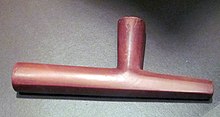Catlinite
This articleneeds additional citations forverification.(July 2015) |


Catlinite,also calledpipestone,is a type ofargillite(metamorphosedmudstone), usually brownish-red in color, which occurs in amatrixofSioux Quartzite.Because it is fine-grained and easily worked, it is prized byNative Americans,primarily those of thePlains nations,for use in makingceremonial pipes,known aschanunpasor čhaŋnúŋpas in theLakota language.Pipestone quarries are located and preserved inPipestone National MonumentoutsidePipestone, Minnesota,inPipestone County, Minnesota,and at thePipestone RiverinOntario,Canada.
Name
[edit]The termCatlinitecame into use after the American painterGeorge Catlinvisited the quarries in Minnesota in 1835; but it wasPhilander Prescottwho first wrote about the rock in 1832, noting that evidence indicated thatAmerican Indianshad been using the quarries since at least as far back as 1637.
Catlinite properties and quarries
[edit]
Minnesota catlinite is buttery smooth and can be cut with a regular hacksaw or even a knife. It comes out of the ground a pinkish color often with a cream layer protecting it from the hard quartzite. It is weaker and more subject to breaking under stress than Utah pipestone.[1]Most catlinite deposits exist beneath the level of groundwater or are in deep enough layers where the soil is constantly moist as the iron compounds which give catlinite its red color quickly convert into iron oxides when exposed to the elements and the stone degrades and breaks down.[citation needed]
The red catlinite from the Pipestone, Minnesota quarries is a softclaystonebed which occurs between layers of hardSioux Quartzite.[2]Only hand tools are used to reach the catlinite so it takes a long time to get to it. Only enrolled Native Americans are allowed to quarry for the stone at the Pipestone National Monument, and thus it is protected from over-mining. Another quarry is located nearHayward, Wisconsinon the reservation, which the Ojibwa have used for centuries. The stone there is harder than the stone from Pipestone National Monument.[citation needed]

Utah pipestone has a more variable range of hard and soft forms, since it occurs as layers between deposits of harderslates.Utah pipestone is a by-product of slate mining in Delta, Utah, and several natural deposits have been mined and used for pipemaking by Native Americans in the area for millennia.
The Canadian quarry is no longer used, although there are quarries in Canada where another type of pipestone,black stone,is gleaned. TheOjibweuse both the red and black stone for their sacred pipes.
Catlinite is often used to make the hollow tubes inpipeclay triangles.
Other varieties of pipestone
[edit]A large range of pipestones exist, not just those in Minnesota, and numerous Native American tribes use a variety of materials in addition to catlinite for pipemaking.
Pipe clay
[edit]Smoking pipesmolded from wetclayare different from those where the bowl is carved from solid pipestone and then fitted with a wooden stem (as is the case with Catlinite pipes).
TheEastern Band Cherokeeare social smokers, and use molded clay pipes for this purpose.
In the United Kingdom, since the 17th century "pipe-clay" has meant a pale, whitish clay. TheOxford English Dictionarydefines it as "fine white kind of clay, which forms a ductile paste with water". It is traditionally used for all sorts of polishing and whitening purposes as well as for makingtobacco pipesand pottery.
Notes
[edit]References
[edit]- Sigstad, John S. (1970) "A Field Test for Catlinite".American Antiquity35:3. pp. 377–382.
External links
[edit]- Mississippi Valley Archaeology Center at the University of Wisconsin - La Crosse:Describes the process of making pipes from Catlinite
- Pipestone Artifacts from Upper Mississippi Valley Sitesby J. T. Penman and J.N. Gundersen in the Plains Anthropologist
